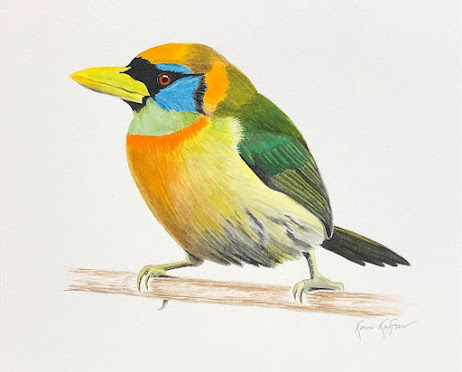Owls: So captivating. So vexing.
With social media dominating our lives, we see this played out more than ever before. It's frustrating, disturbing, and it seems impossible to ever resolve. Still, I think it's worth discussing.
Here are a few questions to help frame the discussion.
1) Are we *too* concerned about this?
I'm speaking specifically about owls in public areas: parks, wildlife areas, etc. Are we making a big deal about something the birds will just deal with themselves? Does it really harm the birds? Birds have wings and they use them. If there's too much human activity, won't they just move on? Are we spending too much time and energy on a few single birds - while global populations of birds are in peril as millions of acres of habitat are wiped off the planet? (Remember, I'm posing this as a question for discussion. This is NOT my position statement on the matter!)
 |
| A Barred Owl along a very active hiking trail. We were very close to this bird (actually it was close to us), and it did flush after a few minutes when our small group stopped to admire it. |
2) Far too often, experienced / advanced birders cast shame down upon those who lack the experience to understand or judge the bird's behavior. We act as though the birds should be left alone, and yet...we've all gone out to see these magnificent animals. (Repeatedly!) What gives us the right to deny others the experience? Instead, shouldn't we do our best to encourage them to go see the bird, but give them the knowledge and the skills to do so in a responsible manner? Clearly, owls inspire people. Shouldn't we take advantage of that to draw them in and help them fall in love with all birds?
3) When photos of owls are posted in Facebook birding groups -- even birds looking completely stressed and in the verge of flushing from their perch -- they receive more likes and positive comments than any other birds. This positive reinforcement of poor birding etiquette drives many others to go out and attempt to get IN YOUR FACE shots of owls, too. But, even with the most gentle, polite suggestions attempting to educate, the push back is swift and harsh. (I realize this isn't really a question, more of a conundrum that I needed to vent.)
4) In the last decade (or so) there's been a massive effort to encourage people to take up birding. Are we doing enough to teach them how to be *responsible* birders? In addition to workshops on how to use optics and where to find birds, maybe we need to develop more robust programs that incorporate birding ethics, with a focus on problematic birds like owls.
Again, I'm not looking for a simple solution. I'm more interested in a civil discourse on this issue, hearing and learning from others, and trying to develop my own approach. And of course I hope others will benefit from the conversation, as well.







Thank you for posting this. I'm not surprised that nobody has commented on this so far. I've found you through a search while I was researching for an article I'm writing on snowy owls and photographers.
ReplyDeleteI'm not sure what the answer is, and I definitely agree with #2. I do my best to state in my commentary that in no way am I suggesting that people shouldn't be taking photos at all. They should, and they should share. I think there are two missing ingredients though -
#1 the curiosity - I've met many photographers who've taken numerous snowy owl photos and they didnt know how to tell apart male from female. As quick as anybody would be to say "Google it" for any other topic, for some reason, it seems to be lacking on this topic.
#2 - the part where you say "responsibly" Seeing an entire crowd of over 20-30 adults gathered OVER a snowy owl, just because she's 20-30 ft away makes me question whether anybody actually wants to take reponsibility. The mentality seems to be more on "well he's taking a photo, I will too" rather than be the one to care.
I try to educate and connect the dots with people. If you want to be able to take snowy owl shots in the future, you should really take note... We can hope that something is going to "click."
Thank you for creating the open platform.